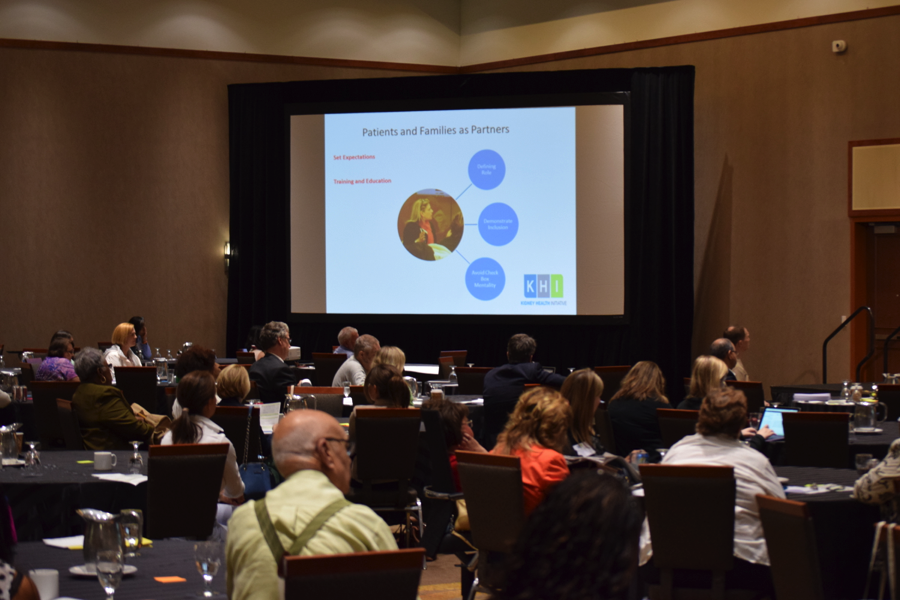You may remember Part I of this blog that focused on the experiences of two PatientsLikeMe members who attended the Kidney Health Initiative’s (KHI) workshop, “Understanding patients’ preferences: Stimulating medical device development in kidney disease,” back in August. KHI is a partnership between the U.S. Food and Drug Administration (FDA) and the American Society of Nephrology (ASN). We recently spoke with patient Celeste Lee and Frank Hurst, MD, Medical Officer, Renal Devices Branch with the FDA, about the planning and consideration it took to make this event “Patients Included.”
While this was the first patient-centric event KHI has held, they’ve worked to include the patient voice in all aspects of the initiative. Kidney patients and kidney patient organizations are represented on the KHI Board of Directors, and this past year the KHI Board of Directors formed a KHI Patient and Family Partnership Council (PFPC) made up of only patients and their caregivers. The PFPC helps provide strategic guidance on how to engage and include patients, their families and care partners in KHI activities.
Celeste has had kidney failure from an autoimmune disease since she was 17. She’s been an advocate for decades and is now focused on patient-centered care. Celeste is also a board member on the inaugural PFPC and helps review potential projects from a patient and family member viewpoint.
“The way KHI works is that it brings everyone to the table – researchers, industry professionals, patients – and we ask what is it that we can do to improve research and clinical trials and ultimately, patient lives. We do this through specific projects like this workshop,” she says.
Involving patients from the get-go
As part of this particular workshop, KHI wanted to hear patients’ ideas and preferences on new devices to manage kidney disease. Before anything, though, they had to create an event that would provide the greatest value to patients that attended in person.
When we asked Frank and Celeste what goes into planning an event like this they shared how they think it can be centered around the patient:
“Involving patients early helped us to realize the need to broaden efforts to educate patients on the topics of interest prior to having the workshop. This proved to be a critical step in the planning process,” says Frank.
“We realized it would save time to educate prospective attendees about the new devices via webinars before the workshop,” explains Celeste. “We ended up taking a three-step approach that started with a quick engagement video talking about what we wanted to do. We distributed this throughout the whole kidney community. At the end of the video, there was an invitation to sign up for the webinars. After the webinar we said – now we are going to have a day and a half workshop and we will provide travel grants. Over 50 travel grants were given, funded by KHI so patients could come from all over the country.”
Frank notes, “Although patients are medical device consumers, they rarely have an opportunity to influence products that come to market. The success of a new medical device is based on many factors, including the usability by patients. KHI provided a forum, which allowed stakeholders to hear about ideas and potential solutions directly from patients.”
Looking at it from all angles
While the main consideration was making sure KHI had set clear expectations to patients who attended from the onset, there were additional logistics to consider for the workshop to be as patient-centric as possible. The workshop agenda was arranged around patient treatment schedules and incorporated dietary considerations when planning the menu. Because some attendees are on dialysis or live with transplants, they needed volunteers on hand. KHI planners also made sure to ask for patient feedback throughout the entire event and had scribes in position to record it. This feedback was ready to be shared at the workshop’s closing and will be sent out in an executive summary as well.
“Patients especially enjoyed the small group sessions,” Frank says. “These were multi-stakeholder breakout discussions which tackled important questions such as unmet needs, device areas that need improvement, making clinical trials more patient-friendly, and assessing ways for patients, industry, and regulators to communicate and share feedback. These sessions included many lively discussions where patients felt empowered to share ideas and come together to propose solutions.”
Patient advice for a patient-centric event
Celeste has simple advice for other organizations that want to have this level of patient inclusion in their events. “I think you start off with a really good planning team that includes patients so that they’re there to help figure out the challenges of bringing that population together. Most importantly – you need to prepare people to be a part of it. You’re not going to get anything of value if people come in cold. It’s about the patient being able to draw on their experiences to help move research forward so if they understand what’s expected of them going in, then the outcomes will be more valuable.”
Frank adds, “It is also important to consider the spectrum of the disease, and ideally include patient representatives from across the spectrum as they could have very different needs.”
“Then,” Celeste says, “the next step is getting them to share the developments within the greater community. Once patients are educated and engaged, they become empowered.”
For a look at the KHI’s 3-step plan, check out this presentation they shared with us! And of course, don’t forget to visit the site and connect with the more than 1,000 other PatientsLikeMe members living with chronic kidney disease.
 Share this post on Twitter and help spread the word.
Share this post on Twitter and help spread the word.

